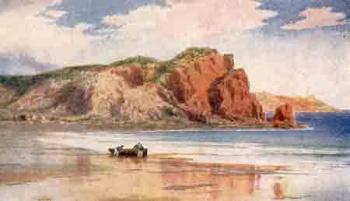Neandertals
Neandertals once lived here around 250,000 years ago - the earliest record of the occupation of the Channel Islands by an intelligent species.
At that time, with sea levels slightly below those at present, Jersey was part of Normandy, a peninsula jutting out from the coast. It was not until after the last Ice Age that the sea eroded the coastline, separating first Guernsey, then Jersey and finally the Ecréhous from the mainland.
History
The cave at La Cotte is the oldest known site of human habitation in Jersey, having yielded remains that can be dated to 250,000 years ago.
Systematic archaeological excavations began in the cave 100 years ago and significant finds were soon recorded.
Teeth which were classified as belonging to Neanderthal man were found by Robert Marett and his team during work that began in 1910 and 1914. It is now thought that the Neanderthals were not direct ancestors of modern man, Homo sapiens, but a branch of the human evolutionary tree which became extinct many thousands of years ago.
But anthropologists and archaeologists believe that Neanderthals were creatures of high intelligence who most certainly possessed what we would regard as a ‘culture’.
They fashioned stone tools, appear to have understood the use of fire and lived in small groups whose members must have co-operated with each other.
Just how effective these people were when it came to hunting the ‘megafauna’ of their age, woolly rhinoceros and woolly mammoths, became apparent during later work at La Cotte, when skulls of these great beasts were found tucked under a ledge.
Hand axes and scraping tools that have been found, plus marks on bones, suggest that carcasses were butchered on site.This perhaps helps to solve one of the puzzles about La Cotte. As a sea cave formed when the sea level was considerably higher than today and long, long before hominids of any sort appeared on the scene, it would not have been the most obvious place to find comfortable shelter.
It is, however, conveniently close to a natural feature of the landscape which, it has been hypothesised, could have been used as a highly effective aid to hunting large and no doubt dangerous creatures. It is suggested that far from trying to corner and spear a mammoth or a rhino, the cave's occupants concentrated on driving their prey over the cliff to certain death.
This is certainly plausible, but when Marett carried out his excavation he elicited the help of another scientist whose own work demonstrated all too clearly how difficult it can be to interpret even tangible evidence. The scientist was Arthur Smith Woodward, of the British Museum, who at the time of the first La Cotte dig was engaged in work on the Piltdown skull, one of the most notorious fakes in the history of anthropology.
In the 1960s and 70s teams from Cambridge University undertook further excavations in the cave, discovering not only the massive skulls, but other teeth and bones from animals of the Pleistocene era. To date, the site has yielded 140,000 artefacts. Under the direction of C M B Burney, one of the young excavators who made a contribution at La Cotte – and attracted plenty of media attention – was Prince Charles, then a university student.
The old Jersey name for the cave was Lé Creux ès Fées, literally The Fairy Hollow.
Excavations
Excavations have taken place from around 1910 onwards.
- Robert R. Marett (1866 - 1943) worked on the palaeolithic site from 1910 - 1914, recovering some hominid teeth and other remains of habitation by Neanderthal man. He published "The Site, Fauna, and Industry of La Cotte de St Brelade, Jersey" (Archaeologia LXVII, 1916).
- In 1911, Arthur Smith Woodward (director of the geology department at the British Museum of Natural History) was asked by R.R. Marrett to inspected the findings at La Cotte. At the time, Woodward was engaged in the archaeological discovery of "Piltdown man", which later became notorious as a hoax, and he used a comparison of findings at La Cotte to argue for an early dating of his Piltdown material.
- The Cambridge University excavations of the 1960s and 1970s found important examples of remains of Pleistocene mammals carried into La Cotte, including a pile of bones and teeth of woolly mammoth and woolly rhinoceros. Prince Charles took part (as a student) in these excavations, directed by Professor C.M.B. McBurney, which were later published.
- Katharine Scott, in 1980, published an article on the hunting methods used by Neanderthals at La Cotte in which she explains how they stampeded and drove the mammoths off the nearby cliffs.
- In 2010 excavations were renewed at La Cotte by a multi-disciplinary team from British Institutions including UCL, The British Museum the University of Southampton and University of Wales Trinity Saint Davids. These on-going excavations revealed new archaeological levels at the site.
- Mammoth Hunters a Jersey Heritage article by Olga Finch
- Another detailed article on the cave


